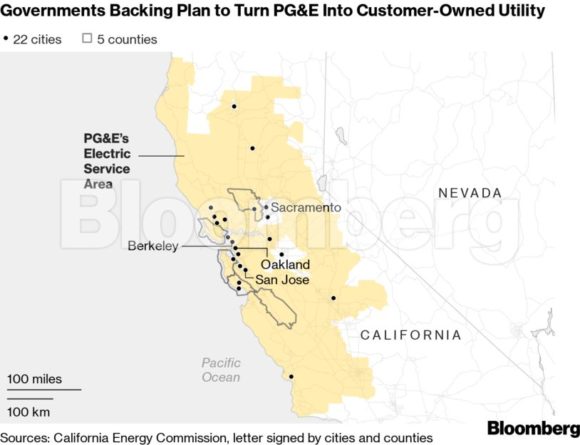For California Governor Gavin Newsom, sitting back and watching PG&E Corp.’s bankruptcy run its course is no longer an option.
The mayors of 22 cities are pressing him to turn the embattled power giant into a customer-owned cooperative. San Francisco, the city he once served as mayor, wants to take over the company’s local poles and wires. And on Wednesday, a board member of a statewide consumer group sent Newsom a proposal that would have the state run PG&E like a massive municipal utility.
The proposals reflect a groundswell of anger against PG&E following years of deadly wildfires sparked by the company’s power lines, and most recently, deliberate mass blackouts that plunged millions of Californians into darkness four times last month. They also underscore the growing pressure that Newsom, who took office just weeks before PG&E filed for bankruptcy, is facing to step in and fix the troubled power company.
“He will be judged — and he’s already being judged — by how he manages this transition,” said Katie Bays, co-founder of Sandhill Strategy consulting.
Newsom’s office didn’t immediately respond to a request for comment.
The proposal submitted Wednesday envisions turning PG&E into a public utility governed by a board that could either be elected or appointed. It doesn’t spell out exactly how the state would finance such a plan, but says PG&E’s power plants could be sold and its transmission lines spun off into a separate not-for-profit entity. The new board would “facilitate” efforts by San Francisco and other communities to buy pieces of PG&E.
“PG&E will never again be able” to provide “safe and reliable service at just and reasonable rates,” Jeff Shields, board treasurer of consumer group The Utility Reform Network, said in his proposal to Newsom. “Their culture of criminal conduct and repeated disregard for public safety must end under your leadership.”
In some ways, Newsom has already involved himself in PG&E’s reorganization. He’s called on companies and cities to make bids on PG&E’s assets, saying he was unimpressed with the restructuring plans that had been presented in its Chapter 11 case. He pulled stakeholders, including PG&E Chief Executive Officer Bill Johnson, into a closed-door meeting to press for a quick exit from bankruptcy. He’s fighting PG&E’s plan to pay wildfire insurers $11 billion and has threatened a state takeover if the company fails to act soon.
‘A Different Model’
Should he make good on that threat, he’ll have options. Backers of both the co-op and municipal utility ideas say their proposals would establish a new PG&E capable of regaining the public’s trust. And more pitches may follow.
“We all just need to work together to create a different model, because the current model of a PG&E driven by Wall Street and dividends, it just doesn’t work,” state Senator Scott Wiener said in an interview. The San Francisco Democrat is working on a bill to be introduced by February that would convert PG&E into a public utility. He said he’s still hashing out the details.
Even those on Wall Street are looking to state leaders to do more about power line-sparked wildfires and mass blackouts before they wreak long-term havoc on California’s economy. Already, the combined impact of this year’s fires and power shutoffs — estimated at as much as $11.5 billion — could put such a large dent in California’s economic output that the state might underperform the U.S. economy for the first time since 2010, said Scott Anderson, chief economist at Bank of the West.
“The earlier an enduring policy solution is implemented, the less risk to the state’s long-term credit,” Wells Fargo Securities senior analysts Randy Gerardes and George Huang wrote in a report.
Any effort to remake PG&E would be complex. The company serves 16 million people spread across 70,000 square miles, including mountains, farmland and dense cities.
The cooperative proposal would leave the company relatively intact but change its governance and business model. As a co-op, the new PG&E would have lower financing costs than the investor-owned company does, said Dan Richard, a former PG&E senior vice president of public policy who helped draft the cities’ plan. The company would issue bonds to pay off its debts, which Richard said conservatively range from $45 billion to $50 billion.
Whatever Newsom does must turn PG&E into a dramatically different institution with new governance, Bays said, because Californians won’t stand for anything less. “The governor absolutely pays consequences for allowing that to happen,” she said.
Was this article valuable?
Here are more articles you may enjoy.


 Gallagher: Global Insured Natural Disaster Claims Again Dominated by Severe U.S. Storms
Gallagher: Global Insured Natural Disaster Claims Again Dominated by Severe U.S. Storms  SC High Court Strikes ‘Troubling’ Denial of Comp Claim, Says Can’t Be Based on Stats
SC High Court Strikes ‘Troubling’ Denial of Comp Claim, Says Can’t Be Based on Stats  DraftKings Sued Over ‘Risk-Free’ Bets That Were Anything But
DraftKings Sued Over ‘Risk-Free’ Bets That Were Anything But  California Sees Two More Property Insurers Withdraw From Market
California Sees Two More Property Insurers Withdraw From Market 